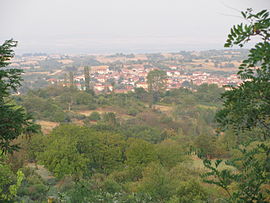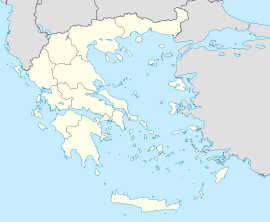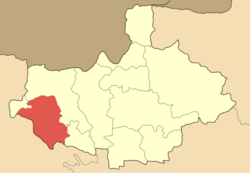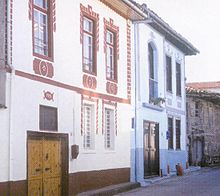- Goumenissa
-
Goumenissa
Γουμένισσα
GoumenissaLocation Coordinates 40°56′N 22°27′E / 40.933°N 22.45°ECoordinates: 40°56′N 22°27′E / 40.933°N 22.45°E Government Country: Greece Region: Central Macedonia Regional unit: Kilkis Municipality: Paionia Population statistics (as of 2001) Municipal unit - Population: 6,819 - Area: 200.33 km2 (77 sq mi) - Density: 34 /km2 (88 /sq mi) Other Time zone: EET/EEST (UTC+2/3) Elevation (center): 268 m (879 ft) Postal: 613 00 Telephone: 2343 Auto: ΚΙ Website www.goumenissa.eu Goumenissa (Greek: Γουμένισσα) is a small town, capital of the former Paionia Province, Kilkis peripheral unit, Greece. Since the 2011 local government reform it is part of the municipality Paionia, of which it is a municipal unit.[1] The town sits on the southeastern part of the Paiko mountain range. Located 69 km northwest of Thessaloniki, 539 km north of Athens and 20 km north of Pella, the ancient capital of the kingdom of Macedon.
Goumenissa is also the seat of the Bishop of Diocese of Goumenissa, Axioupolis and Polykastron (Greek: Ιερά Μητρόπολις Γουμενίσσης, Αξιουπόλεως & Πολυκάστρου.
Goumenissa has splendid narrow streets lined with traditional houses and is renowned for a wide range of things; apart from its preindustrial monuments built beside lush springs, there are traditional wineries which prove the expertise of this small country town to produce good quality wine. Its multifarious identity accounts for the unfailing enthusiasm overwhelming the different kinds of tourists Goumenissa attracts. Its folklore museum, its impromptu brass bands (Ta Chalkina tis Goumenissas, The Brass Band of Goumenissa) as well as its customs, events and fetes, all of them are reflective of the traditional lifestyle that has resisted the course of time.
Contents
Name
There are a lot of versions of the origin of the name Goumenissa. According to the local tradition, robbers hung the Abbot (Greek: Ηγούμενος egoumenos) of the abbey, and the city's name , which means place of Abbot derived from this; In Bulgarian it was called Гуменидже Gumenidzhe.
History
Hellenistic Era
Further information: Hellenistic GreeceThe town is located in part of the ancient Paeonia, the exact boundaries of which, like the early history of its inhabitants, are very obscure. According to Herodotus (v. 16), they were Teucrian colonists from Troy. Homer (Iliad, book II, line 848) speaks of Paeonians from the Axios River fighting on the side of the Trojans, but the Iliad does not mention whether the Paeonians were kin to the Trojans. Homer gives the Paionian leader as a certain Pyraechmes; later on in the Iliad a second leader is mentioned, Asteropaeus son of Pelagon.
Roman Era (146 BC - 330)
Further information: Roman GreeceAfter the Roman conquest of Macedon in 146 BC, Paionia east and west of the Axios formed the second and third districts respectively of the Roman province of Macedonia (Livy xiv. 29). Centuries later under Diocletian, Paionia and Pelagonia formed a province called Macedonia secunda or Macedonia Salutaris, belonging to the Praetorian prefecture of Illyricum.
Byzantine Era (330 - 1387)
Further information: Byzantine GreeceWhen the Roman Empire was divided into eastern and western segments ruled from Constantinople and Rome respectively, Goumenissa came under the control of the Eastern Roman Empire (Byzantine Empire). Goumenissa passed out of Byzantine hands in 1204, when Constantinople was captured by the Fourth Crusade and became part of the Kingdom of Thessalonica - the largest fief of the Latin Empire, covering most of north and central Greece.
In 1224 it was seized by Theodore Komnenos Doukas, the Greek ruler of Despotate of Epirus. The area was recovered by the Byzantine Empire in 1246. First report with the name Goumenissa we have at the year 1346, at the era of Palaiologos Dynasty. In an Imperial Act of this year, the region of Goumenissa is granted in the Holly Abbey Ibyron of Mount Athos and becomes religious centre because of the Monastery of Virgin Mary. Next to Monastery existed a settlement that little later with the union of small agro-pastoral settlements will create a dynamic town that will be named Goumenissa.
Ottoman Era (1387 - 1912)
Further information: Ottoman GreeceThe Ottomans had captured Goumenissa in 1387. Under the rule of the Ottoman Empire the area was characterized self-governed town and acquired privileges because of the important production of buckram, used for the military uniforms of the Ottoman army. Goumenissa prospered during the 19th century and became economic, cultural and religious centre of the region. The famed wine of Goumenissa, made out of local varieties like Xinomavro, become popular in the Ottoman Empire and beyond, particularly in Central Europe.
Even though being a town with privileges, it was not uninvolved in the Greek War of Independence of 1821. By the outbreak of the revolution, the Ottoman army conducted searches of premises and found 49 rifles. This led to violent islamization ordered by Pasha of Thessaloniki Abdul Abud. The punishment included the handing over of money, food, animals and carriages.
The Russian slavist Victor Grigorovich in 1845 recorded Igumencho as mostly Bulgarian village.[2] The first Bulgarian school was founded in 1866-1867.[3]
The Macedonian Struggle
Further information: Macedonian StruggleBy 1899, the Bulgarian guerrillas of the Internal Macedonian-Adrianople Revolutionary Organisation (IMRO) turned against Ottoman authorities. Gradually, tensions increased among the followers of the Patriarchate of Constantinople (mostly Greeks) and those of the Bulgarian Exarchate (exclusively Bulgarians) to the point of armed conflict.
The rioting in Macedonia, the atrocities of Bulgarian guerrilla troops against Greek locals and especially the death of Pavlos Melas (killed by Turks in 1904) caused intense nationalistic feelings in Greece. This led to the decision to send more Greek guerrilla troops in order to thwart Bulgarian efforts.
The village also had supporters of the Bulgarian cause. Notably, 21 persons joined the Macedonian-Adrianopolitan Volunteer Corps[4]
Conflicts ended after the revolution of Young Turks in July, 1908, as they promised to respect all ethnicities and religions and generally to provide a constitution.
On October 23, 1912, during the course of the First Balkan War Goumenissa was conquered by the Greek army and incorporated into the Greek Kingdom.
Greek Macedonian fighters [5]
- Goumenissa: Dimitrios Aliris, Ioannis Aliris, Christos Aliris, Ioannis Vouzas, Vassilios Karakolis, Athanassios Maltsis, Georgios Metaxas, Georgios Pazaretzos, Ioannis Papageorgiou, Nikolaos Papamanolis, Ioannis Pissoutas, Athanassios Pipsos, Georgios Poulkas, Aggelos Sakellariou, Eleni Samara, Georgios Samaras, Dimitrios Samaras, Konstantinos Samaras, Athanassios Slapakis, Dimitrios Slioupikidis, Athanassios Tzanas, Georgios Totsis, Christos Toumpas, Athanassios Tsimirikos, Nikolaos Chatzivrettas, Christos Chatzidimitrakis
- Kastaneri": Georgios Dogiamas, Lazaros Dogiamas, Traianos Dogiamas, Christos Dogiamas, Traianos Touloupis,
- Karpi": Athanassios Zaras, Athanassios Betsis, Traianos Partoulas, Georgios Softsis, Traianos Softsis,
- Griva": Ioannis Ekonomou, Christos Poulkas, Christos Pipsos
Bulgarian Macedonian fighters
- Goumenissa: Ichko Boychev (1882–1960),[6] Ivan Limonchev,[7] Ivan Alev (1851–1919),[8] Konstantin Dzekov,[9] Mihail Chakov,[10] Hristo Batandzhiev, Hristo Shaldev,[11] Vangel Gologanov,[12] Gono Azarov,[13] Domitar Shotev,[14] Ivan Karadzov (1870–1913).[15]
Modern Era (1912 - present)
Further information: Axis occupation of Greece during World War IIDuyring World War I, late 1915, Franco-British divisions under the command of French General Maurice Sarrail marched on Paionia Province. A French Division camped in Goumenissa and built a military hospital, a power station and the famous Fountain in Central Square.
The population exchanges among Greece, Turkey, and Bulgaria after 1923 resulted in the replacement by Greek refugees from Asia Minor and Romilia region of most of the Slavic and Turkish elements.Greek Macedonia experienced radical demographic transformations with the arrival of the Greek refugees; by 1928, 427 families comprising 1,676 inhabitants arrived from Turkey.[16] The Macedonian-speaking minority in Greek Macedonia, who were referred to by the Greek authorities as “Slavomacedonians”, “Slavophone Greeks” and “Bulgarisants”, were subjected to a gradual assimilation by the Greek majority. Their numbers were reduced by a large-scale emigration to North America in the 1920s and the 1930s and to Eastern Europe and Yugoslavia following the Greek Civil War (1944–1949)[citation needed]. During World War II Goumenissa and Central Macedonia were occupied (1941–44) by Germany.
In the 50s there was a massive emigration to the United States, Australia, Canada, West Germany and other Greek cities, mainly to Thessaloniki and Athens. In the 80s many civil war refugees were allowed to re-emigrate.
Subdivisions
The municipal unit Goumenissa is subdivided into the following communities:
- Goumenissa (η Γουμένισσα) Town Hall
- Griva (η Γρίβα)
- Gerakon (η Γερακών)
- Karpi (η Κάρπη)
- Kastaneri (η Καστανερή)
- Omalos (ο Ομαλός)
- Pentalofon (το Πεντάλοφον)
- Stathis (ο Στάθης)
- Filyria (η Φιλυριά)
Mayors of Goumenissa
Mayor From To Elected Backed by Christos Karakolis (Χρήστος Καρακόλης) January 1, 1983 December 31, 1990 October 1982 60%, October 1986 52% PASOK, KKE, KKE Interior Dimitrios Pakos (Δημήτριος Πάκος) January 1, 1991 December 31, 1994 October 1990 53,7% New Democracy Dimitrios Petsos (Δημήτριος Πέτσος) January 1, 1995 December 31, 1998 October 1994 52,8% PASOK Vasilios Patsis (Βασίλειος Πάτσης) January 1, 1999 December 31, 2002 October 1998 52,6% New Democracy Dimitrios Petsos (Δημήτριος Πέτσος) January 1, 2003 December 31, 2006 October 2002 50,96% PASOK Stylianos Papapanagiotou (Στυλιανός Παπαπαναγιώτου) January 1, 2007 October 2006 52,35% New Democracy Landmarks
 Two rivers.
Two rivers.
- Central Square
- The French Fountain
- Square of St. George
- Small Square
- Folklore Museum of Goumenissa
- Silk Factory
- Boutari Winery, Aidarinis Winery, Domaine Tatsis, Distillery Dimitri Kambouri
- Two Rivers
- Traditional mountainous settlement of Kastaneri
Monasteries
- Monastery of the Virgin Mary at Goumenissa (Est. 1100)
Belongs to: Diocese of Goumenissa
- Monastery of St. Nikodimos at Pentalofon (Est. 1981)
Dependency of: the Monastery of Simonos Petra, Mount Athos
- Monastery of St. Raphael, Nicholas & Irene at Griva (Est. 1992)
Belongs to: Diocese of Goumenissa
- Monastery of St. George at Anydron (Est. 1991) (convent)
Belongs to: Diocese of Goumenissa
Demographics
According to the National Statistical Center of Greece, as of 2001, Goumenissa was the third largest town in population in Kilkis Prefecture, with an estimated population of 4,073.
District 2001 1991 +/- % Goumenissa (Γουμένισσα) 4,073 4,163 -2,16 Griva (Γρίβα) 813 779 +4,18 Stathis (Στάθης) 418 465 -10,11 Karpi (Κάρπη) 400 391 +2,30 Gerakon (Γερακών) 286 350 -18,29 Filyria (Φιλυριά) 279 304 -8,22 Kastaneri (Καστανερή) 237 344 -31,10 Pentalofon (Πεντάλοφον) 191 231 -17,32 Omalon (Ομαλόν) 122 145 -15,86 TOTAL 6,819 7,172 -4,92 In Goumenissa live a population of 300 of Rom origin. They live in the south-eastern department of city, which in 1983, with an Act of Municipal Council, was named “Settlement of Saint George”.
Economy
Goumenissa is a famous wine producing region with Appellation d’origine de Qualite Superieure ,centre of a region that has been renowned for the quality of its wines for hundreds of years.
Culture
Goumenissa as filming location:
- 1986 The Beekeeper (Greek: Ο Μελισσοκόμος)
- Director:Theo Angelopoulos
- Cast: Marcello Mastroianni, Nadia Mourouzi, Jenny Roussea, Dinos Iliopoulos
- 1981 The Factory (Greek: Το Εργοστάσιο)(French L'usine)
- Director:Tasos Psaras
- Cast: Vasilis Kolovos, Dimitra Hatoupi
Club Origin Founded Activities Venue The Paiones (Οι Παίονες) Greek Macedonians 1975 Choruses, tradiotional dancing groups Goumenissa Diogenis Sinopeys (Διογένης ο Συνοπεύς) Pontian 1982 Traditional dancing groups Goumenissa Agios Trifon (Ο Άγιος Τρύφων) Greeks from Romilia region 1979 Traditional dancing groups Goumenissa Agios Georgios (Άγιος Γεώργιος) Greek Macedonians 1983 Brass Bands Goumenissa Griva (Πολιτιστικός Σύλλογος Γρίβας) Greek Macedonians 1983 Tradiotional dancing groups Griva Makedones (Οι Μακεδόνες) Greek Macedonians 1990 Tradiotional dancing groups Stathis To Paiko (Το Πάικο) Greek Macedonians Kastaneri Filyria (Η Φιλυριά) Pontian Traditional dancing groups Filyria Sport clubs
Club Sport Founded League Venue Paiko Goumenissas (Πάικο Γουμένισσας) Football 1950 A' Erasitehniki: Hellenic Football Federation Stadium of Goumenissa Makedonikos Grivas (Μακεδονικός Γρίβας) Football 1978 B' Erasitehniki: Hellenic Football Federation Stadium of Griva Heracles Karpis (Ηρακλής Κάρπης) Football B' Erasitehniki: Hellenic Football Federation Stadium of Karpi Astrapi Stathis (Αστραπή Στάθη) Football Γ' Erasitehniki: Hellenic Football Federation Stadium of Stathis Keravnos Filyrias (Κεραυνός Φιλυριάς) Football Γ' Erasitehniki: Hellenic Football Federation Stadium of Filyria A.O.K.(Αθλητικός Όμιλος Καλαθοσφαιριστών) Basketball 1981 Γ : Hellenic Basketball Federation Gym Stadium of Goumenissa Α.Ο.Γ. (Αθλητικός Όμιλος Γουμένισσας) Athletics 1981 Hellenic Amateur Athletic Association Stadium of Goumenissa Climate
Month Jan Feb Mar Apr May Jun Jul Aug Sep Oct Nov Dec Avg Maximum temp[°C] 9 10 13 18 23 28 31 30 26 21 14 10 Avg Minimum temp[°C] 1 2 5 7 12 16 18 18 15 11 6 2 Rainfall (mm) 40 38 43 35 43 30 22 20 27 45 58 50 Record temperatures [°C] 20 22 25 31 36 39 42 39 36 32 27 26 Transportation
Goumenissa is accessed
- From Athens with GR-1/E75 to Polykastron Interchange
- From Thessaloniki with E86 to Gefyra Junction then E75 to Polykastron Interchange or E86 to Intetchange after 1 km from Nea Pella
- From Igoumenitsa and Alexandroupolis with GR-4/GR-2/E90 (Via Egnatia motorway) to Chalastra Interchange then E75 to Polykastron Interchange
- From the Republic of Macedonia with E75 to Polykastron Interchange
- By bus from Athens and Thessaloniki Bus to Kilkis
- By railway from Thessaloniki and Central Europe to Polykastron Station 15 km from Goumenissa Greek Railways
- By air from Makedonia Airport (SKG) Thessaloniki.If you have a private plane Polykastron Airport 15 km from Goumenissa
References
- ^ Kallikratis law Greece Ministry of Interior (Greek)
- ^ Григоровичъ, В. Очеркъ путешествія по Европейской Турціи, Москва, 1877, стр.91.
- ^ Кирил патриарх Български. Българската екзархия в Одринско и Македония след Освободителната война 1877-1878. Том първи, книга втора, стр. 28.
- ^ „Македоно-одринското опълчение 1912-1913 г. Личен състав“, Главно управление на архивите, 2006, стр. 840.(Macedonian-Adrianopolitan Volunteer Corps. Staff according to documents from Directorate Central Military Archives, Sofia 2006, p. 840.)
- ^ in Greek: "Obscure Native Macedonian Fighters" published by Company of Macedonian Studies, 2008
- ^ Христо Григоров, Ичко Бойчев - горноджумайският войвода. Живот и революционно дело /1882-1960/, Библиотека Македония, София 1999, ISBN 954-679-104-0
- ^ Николов, Борис Й. Вътрешна македоно-одринска революционна организация. Войводи и ръководители (1893-1934). Биографично-библиографски справочник, София, 2001, стр. 94.
- ^ Албум-алманах „Македония“, София, 1931, стр. 110.
- ^ Николов, Борис Й. Вътрешна македоно-одринска революционна организация. Войводи и ръководители (1893-1934). Биографично-библиографски справочник, София, 2001, стр. 46.
- ^ Николов, Борис Й. Вътрешна македоно-одринска революционна организация. Войводи и ръководители (1893-1934). Биографично-библиографски справочник, София, 2001, стр. 184.
- ^ Николов, Борис Й. Вътрешна македоно-одринска революционна организация. Войводи и ръководители (1893-1934). Биографично-библиографски справочник, София, 2001, стр. 189-190.
- ^ „Македоно-одринското опълчение 1912-1913 г. Личен състав“, Главно управление на архивите, 2006, стр.180.
- ^ „Македоно-одринското опълчение 1912-1913 г. Личен състав“, Главно управление на архивите, 2006, стр.14-15 и 754.
- ^ „Македоно-одринското опълчение 1912-1913 г. Личен състав“, Главно управление на архивите, 2006, стр.807.
- ^ „Македоно-одринското опълчение 1912-1913 г. Личен състав“, Главно управление на архивите, 2006, стр. 336.
- ^ Κατάλογος των προσφυγικών συνοικισμών της Μακεδονίας σύμφωνα με τα στοιχεία της Επιτροπής Αποκαταστάσεως Προσφύγων (ΕΑΠ) έτος 1928
External links
- goumenissa.info (Greek)
- Goumenissa (Greek)
- MUNICIPALITY OF GOUMENISSA - SIGHTSEEING
Categories:- Populated places in Kilkis (peripheral unit)
- Tourism in Greece
- Wine regions of Greece
Wikimedia Foundation. 2010.








